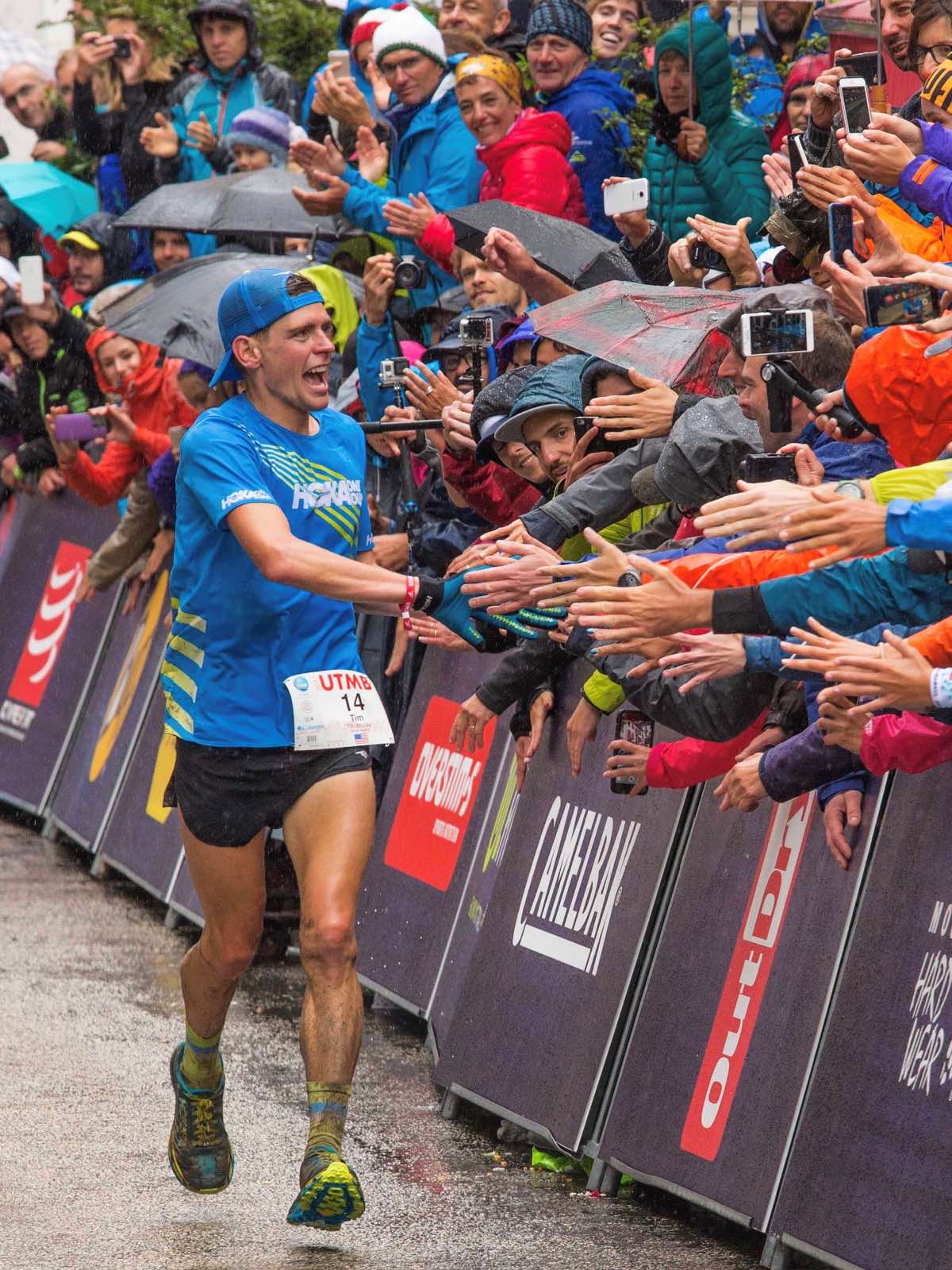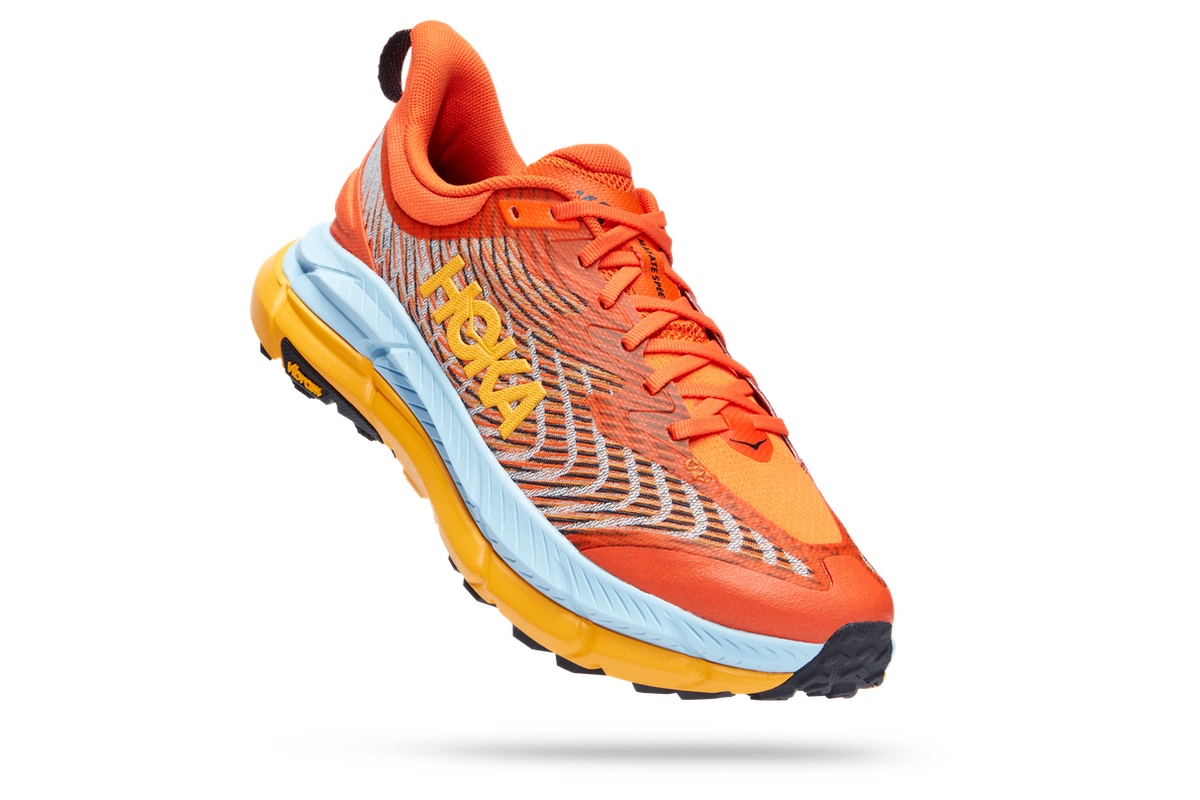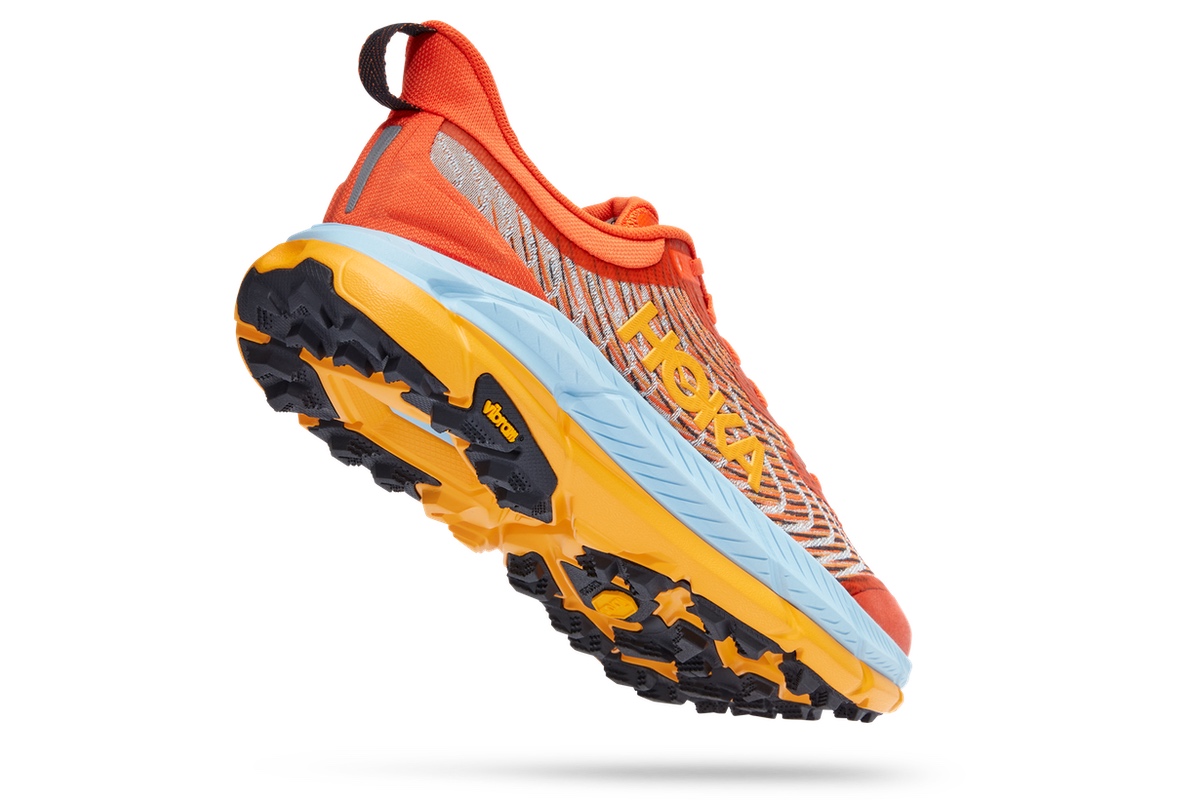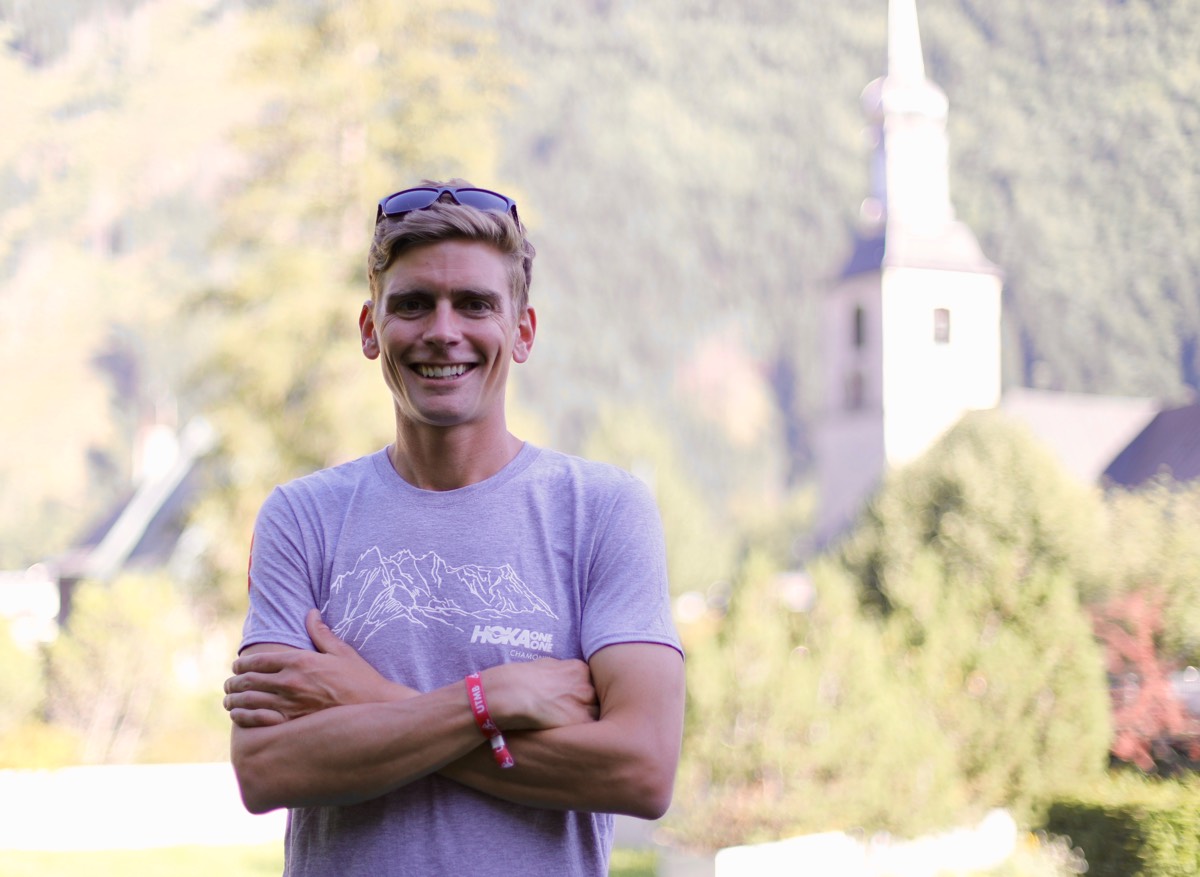Ever since his first encounter with UTMB in 2015 while taking second at the CCC, the 100-kilometer race at the UTMB festival, Tim Tollefson has been fixated with what many consider the greatest mountain ultramarathon in the world.
The UTMB is revered by runners worldwide, its punishing 170-kilometer course with 10,000 meters of climbing starts in Chamonix, France, and circumnavigates Mont Blanc, providing a platform for the best ultrarunners of the world to compete. HOKA-sponsored Tollefson found quick success with the challenging loop. After finishing third in his first two attempts at UTMB in 2016 and 2017, many started to whisper that he’d be the first American man to win the race. Tollefson would go on to drop out the next three times he showed up at the start line.
Now, six years after starting his first UTMB in 2016, with a new outlook on the race and his motivations, but with the same tried-and-true HOKA Mafates on his feet that he’s run the last four editions of the race in, Tollefson feels ready to once again put together a day that he can be proud of.
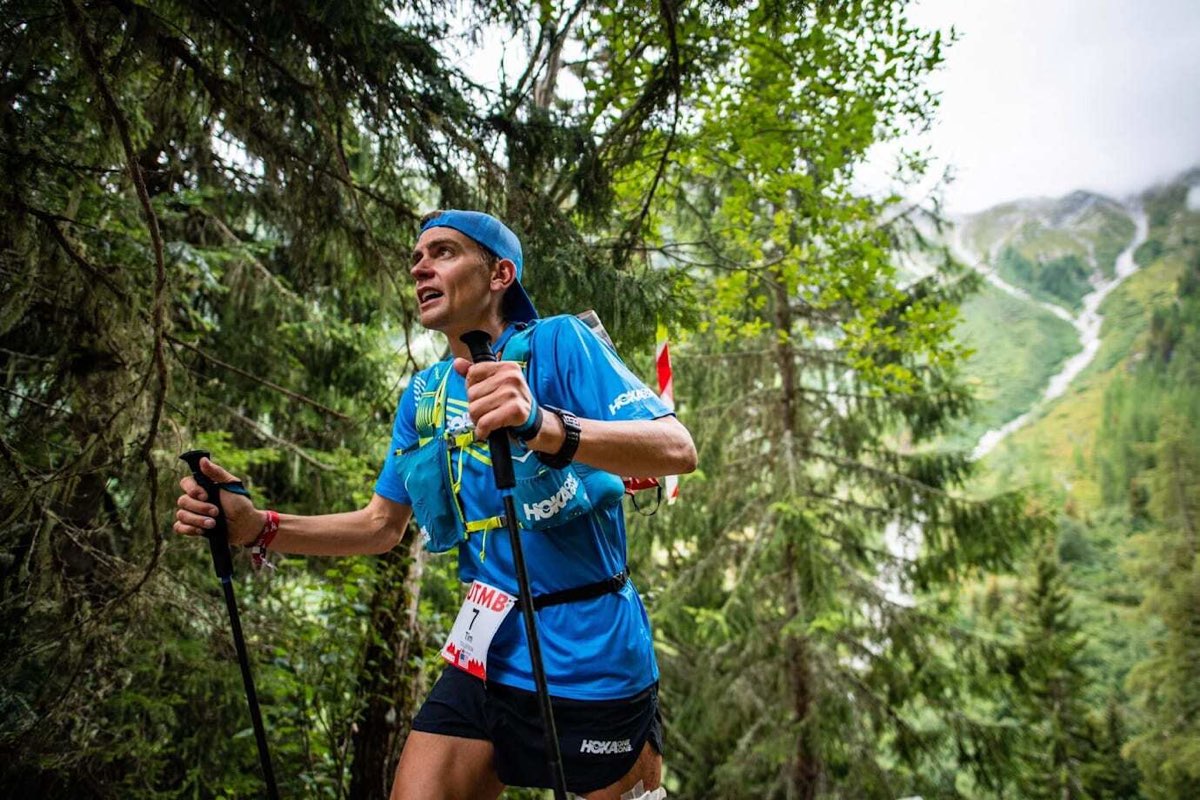
Tim Tollefson at the 2018 UTMB, where he dropped after injuring his leg in a fall. All photos courtesy of HOKA unless otherwise noted.
UTMB: The Pressures of Success
When Tollefson first went over to Chamonix, France, the hub of the UTMB festival, to race the 2015 CCC, American men had seen very little success in long European mountain ultras, and no American man had yet won UTMB. It wasn’t necessarily the chance to visit the Alps or to lay eyes on Mont Blanc that drew Tollefson to the start line of the CCC; it was the chance to compete against the best ultrarunners in the world. He went to Chamonix with the motivation to prove himself as a young runner and to show that American runners could be successful competing in the Alps. He and fellow American Zach Miller did quite well, the pair turning up first- and second-place CCC finishes that year.
Tollefson returned to Europe in 2016 for the full lap around Mont Blanc, finishing his first UTMB third behind Ludovic Pommeret and Gediminas Grinius. The following year, he backed up the performance with another third-place finish. Immediately, the American trail running community started buzzing. Was Tollefson going to finally be the first American male to win UTMB? While American women were seeing regular success at winning the race, the men continued to struggle to reach the top podium spot.
Based out of Mammoth Lakes, California, Tollefson seemed to have solved the puzzle of how to train for the significantly steeper and more rugged European courses. Tollefson understood that to succeed on European courses, he had to harden his body to be able to excel on climbs gaining more than 1,000 feet per mile, and that included doing a lot of powerhiking.
He chose specific routes in Mammoth to mimic the terrain in Europe, adding more steep trails to his training than ever before. A collegiate steeplechaser who had qualified for the Olympic Trials Marathon in 2012 before turning to trail running in 2014, Tollefson seemed to thrive with the new type of training.
But with success came pressure. During UTMB in 2018, Tollefson fell hard on a descent while running with eventual winner Xavier Thévenard, only 50k into the race. The fall left a significant gash on his leg. He carried on for another 90k, slowly slipping back in the field before calling it a day and seeking additional medical attention for his leg.
The years 2019 and 2021 brought two more UTMB DNFs. Tollefson admits that he shouldn’t have even been on the start line for those attempts, but external pressure made starting, even knowing that it wasn’t going to be a good race, seem easier than backing out.
“I would line up knowing that it wasn’t going to go well,” Tollefson remembers, “But I wasn’t strong enough personally to make the decision and say, I’m not going to race.”
When thinking about his reasons to race to UTMB year after year, Tollefson admits that some of them weren’t the most healthy kind of motivations. But they worked.
“All three of my best efforts out there have really been driven out of proving people wrong, just feeling a chip on my shoulder and that I need to prove myself,” Tollefson says. “And that had driven me through those very difficult moments.”
Tollefson is philosophical about what is needed to complete a race like UTMB. “I think in all endurance sports, it’s this simple equation between suffering and reward. When the suffering becomes more powerful than the potential rewards, you’re going to quit and drop out. But if whatever reward you are chasing, intrinsic or extrinsic, outweighs the suffering, you are able to continue and keep moving.” In both 2019 and 2021, his motivations to race and finish just weren’t enough to counteract the challenges.
A Change in Approach
After several years of disappointing runs at UTMB, Tollefson was ready to change his approach to the race. “This year, I’m definitely returning to the valley with a new sense of purpose, recognizing that my best days out at UTMB were when I was not holding myself to an impossible standard and just going out and giving my best on that day. And I think I’m finally back to that place.”
“I really am more just intrigued on getting back and completing the loop. It has been five years since I’ve done that. I know what it takes to have a good day out there, and I think I’m in a place in my career where I’m ready to put that together again.”
Tollefson knows he’s no longer the American man with the highest expectations to do well. Jim Walmsley, with his continued success at seemingly any race that he sets his mind to, and he’s definitely set his mind to UTMB, has taken over that mantle. The reduced pressure seems to fit with Tollefson’s new perspective on racing and his motivations.
“In the past, my best moments were driven out of anger. I don’t know if I want the rest of my career to go that same route because in those moments, I don’t enjoy it. I might get a result that I should be proud of, and other people are proud of for me, but because I wasn’t really able to enjoy it or be present in those moments, it doesn’t exist in my mind. I would rather continue this path of trying to find a healthier and kinder path for myself.”
Shoes for the Mont Blanc Loop
While Tollefson’s approach to UTMB has changed, his choice of shoes hasn’t. The HOKA Mafate has always been his go-to for the notoriously difficult UTMB course. Tollefson has run his past four UTMB races in HOKA Mafates, counting on the protection and cushion the shoe offers to carry him up and down the 170 kilometers and 10,000 meters of vertical gain on rocky and technical trails. Various iterations of the Mafate through the years, including the brand-new HOKA Mafate Speed 4, all provide the grip, stability, and comfort to maximize the chance of success on such a rugged race route.
While Tofellson relies on a quiver of HOKA shoes for his day-to-day training, including the Challenger ATR 6, Clifton 8, and Tecton X, it’s the Mafate that continually gets called up for long runs and races. In the Mafate Speed 4, runners will experience an updated upper, conversion to HOKA’s ProFly midsole foam, and the same trusted Vibram® Megagrip rubber outsole and lug pattern.
Buildup to the 2022 UTMB
Tollefson’s buildup to the 2022 UTMB hasn’t been exactly what he envisioned. When things began to fall apart for him during the Western States 100 earlier this summer, he could have just tossed in the towel and headed home. But with a new mindset to racing, he was able to persevere through the difficulties and finish.
“In the past, if I had that unraveling, I would be more likely to quit. The rewards are no longer there. But I recognized at States that there were so many rewards I was still able to chase, I just had to reframe my definition of success. I was able to come out of that feeling like I had learned more in the final 14 hours of that race than I have in the first eight years of my career.”
Even if the race results didn’t materialize — he finished 21st among the men — Tollefson’s appreciation for running hasn’t changed. “I think I always feel better when I’m in motion,” he says, a claim that most runners can relate to. “I think I’m able to process internal and external things in life with greater efficiency, and probably more responsibly.”
Regardless of what happens during the 170 kilometers of UTMB this year, it seems apparent that Tollefson is going to show up prepared, both physically and mentally, to put together the best performance that he can on the day. And it’s probably fair to assume that he’ll do his best to accept whatever the day brings him and find enjoyment from moving through the mountains and being part of UTMB.
“I think I’m embracing that impermanence of the sport and of life, it’s something that I don’t want to take for granted.”
[Editor’s Note: This article is sponsored by HOKA. Thank you to HOKA for its sponsorship of iRunFar, which helps to make iRunFar happen and free for all to enjoy. Learn more about our sponsored articles.]
